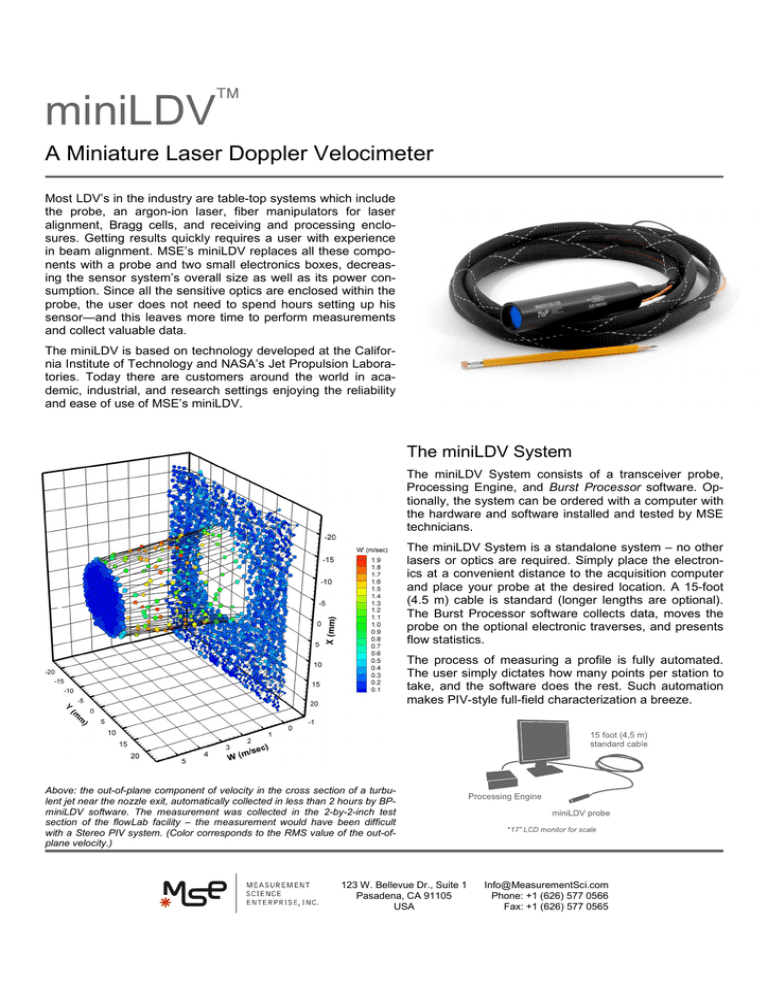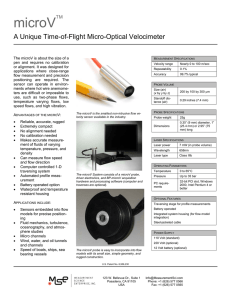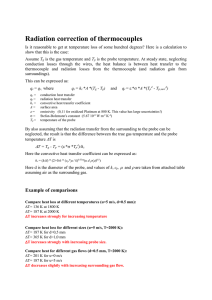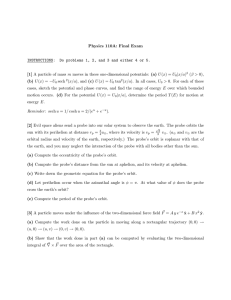miniLDV A Miniature Laser Doppler Velocimeter
advertisement

miniLDV A Miniature Laser Doppler Velocimeter Most LDV’s in the industry are table-top systems which include the probe, an argon-ion laser, fiber manipulators for laser alignment, Bragg cells, and receiving and processing enclosures. Getting results quickly requires a user with experience in beam alignment. MSE’s miniLDV replaces all these components with a probe and two small electronics boxes, decreasing the sensor system’s overall size as well as its power consumption. Since all the sensitive optics are enclosed within the probe, the user does not need to spend hours setting up his sensor—and this leaves more time to perform measurements and collect valuable data. The miniLDV is based on technology developed at the California Institute of Technology and NASA’s Jet Propulsion Laboratories. Today there are customers around the world in academic, industrial, and research settings enjoying the reliability and ease of use of MSE’s miniLDV. The miniLDV System The miniLDV System consists of a transceiver probe, Processing Engine, and Burst Processor software. Optionally, the system can be ordered with a computer with the hardware and software installed and tested by MSE technicians. The miniLDV System is a standalone system – no other lasers or optics are required. Simply place the electronics at a convenient distance to the acquisition computer and place your probe at the desired location. A 15-foot (4.5 m) cable is standard (longer lengths are optional). The Burst Processor software collects data, moves the probe on the optional electronic traverses, and presents flow statistics. The process of measuring a profile is fully automated. The user simply dictates how many points per station to take, and the software does the rest. Such automation makes PIV-style full-field characterization a breeze. Above: the out-of-plane component of velocity in the cross section of a turbulent jet near the nozzle exit, automatically collected in less than 2 hours by BPminiLDV software. The measurement was collected in the 2-by-2-inch test section of the flowLab facility – the measurement would have been difficult with a Stereo PIV system. (Color corresponds to the RMS value of the out-ofplane velocity.) 123 W. Bellevue Dr., Suite 1 Pasadena, CA 91105 USA Info@MeasurementSci.com Phone: +1 (626) 577 0566 Fax: +1 (626) 577 0565 miniLDV A Miniature Laser Doppler Velocimeter The Laser Doppler Velocimetry Concept Conceptually, an LDV system consists of highly coherent light split into two beams and sent through a transmitter which crosses the beams in the probe volume to create a fixed interference pattern. The aberrations of the optics must be low so that the fringes of the pattern are straight throughout the probe volume. The receiver consists of light collection optics and an ultra-fast-response photodiode. The optics are aligned so that any light reflected from the probe volume is focused onto the active area of a photodiode. When a particle passes through the probe volume, it passes through regions of destructive interference (darkness) and constructive interference (brightness) which the receiver sees a sinusoidal wave of intensity. Knowing the fringe separation (calibrating the given transmitter), the frequency of the sinusoid is a measure of the speed of the particle through the probe volume. Sophisticated systems – including the miniLDV – include a frequency shifting component so that the fringes in the probe volume are moving at a constant velocity. The measurement then becomes one of the relative velocity difference between the particle in space and the fringes in the probe volume – thus such a probe can specify flow direction as well as measure speed. The probe volume is formed by splitting a coherent beam and then crossing the two halves in a very small region to generate interference fringes. As seen by the photodetector, the light signal is a sinusoid (corresponding to the fringes) modified by a Gaussian envelope. Flow direction V Probe volume As the particle travels through the probe volume, it reflects light into the receiver only when it crosses a region of constructive interference. t The sinusoid is isolated by a bandpass frequency filter. Particle speed Magnified 75 times 1/f The frequency of the sinusoid is measured (usually by FFT). The fringe spacing is known (from calibration), thus the speed of the particle can be calculated. speed = fringe spacing ´ f U.S. Patent No. 6,654,102 123 W. Bellevue Dr., Suite 1 Pasadena, CA 91105 USA Info@MeasurementSci.com Phone: +1 (626) 577 0566 Fax: +1 (626) 577 0565






